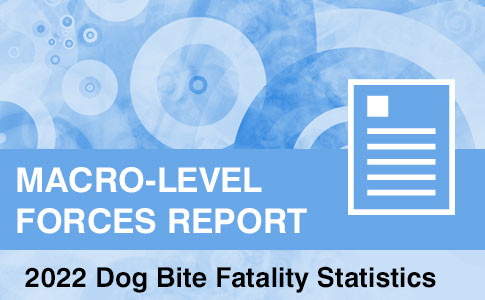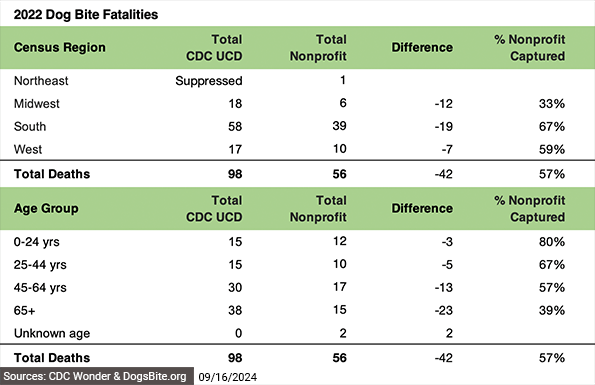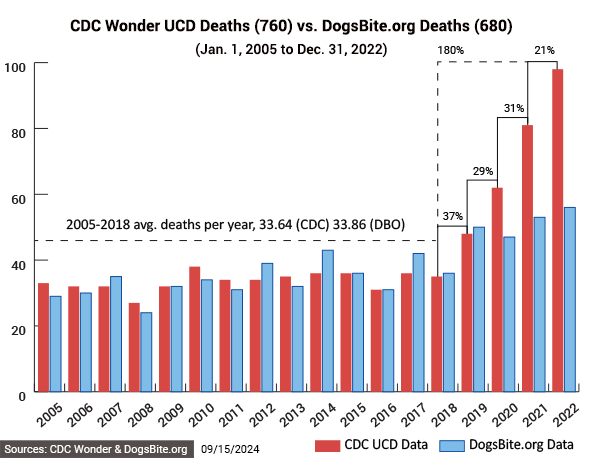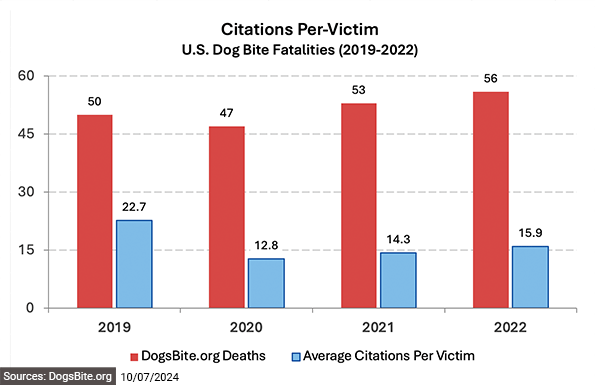Dog Bite Fatalities Surged in 2022; a 104% Increase from 2019

DogsBite.org - Last April, we published the 2021 Macro-Level Forces Report for U.S. dog bite fatality data. Current data shows that during 2021, the second Covid year, our nonprofit had a 28-victim deficit compared to CDC Wonder underlying cause of death (UCD) data, a 42% difference in the number of deaths.1 The victim deficit during the third Covid year, 2022, is even higher. CDC Wonder data shows there were 98 dog bite fatalities in 2022. Our nonprofit recorded 56 deaths, a 55% difference.
98 fatal dog attacks in a single year are the most ever recorded by CDC data. This is a 104% increase from 2019 and a 180% increase from 2018.
Prior to the pandemic (2005 to 2019), the largest deficit of unreported deaths our nonprofit had compared to CDC data was 4 each for the years 2005 and 2010. During 2022, there was a deficit of 42 unreported deaths. Without our FOIAs, the deficit would have been 48. The disparity during 2022 is greater than in 2021 and 2020, even though the average number of citations per victim only fell 30% (15.9) in 2022, compared to falling 44% (12.8) in 2020 from the pre-Covid baseline year of 2019 (22.7).
A regional breakdown of dog bite fatalities in 2022 shows that the South and Midwest had the most unreported deaths. According to CDC Wonder data, 69% (68 of 98) of the victims in 2022 were ≥ 45 years old. Our nonprofit only captured 47% (32 of 68) of these deaths. However, we already knew the 50 and older age group was underrepresented in media reports. We discussed this disparity in our 2020 discussion notes (Comparing 15-Year Data Sets - DogsBite.org Data and CDC Wonder Data).
Related report:
2022 Macro-Level Forces Report: CDC Dog Bite Fatality Data Compared to Nonprofit

U.S. dog bite fatalities during the third Covid year, 2022, by Census region and age
Characteristics of Unreported Fatal Dog Attacks (2005 to 2024)
Since 2011, we have uncovered 36 unreported deaths through FOIAs or other means. Most of them, 61% (22), occurred after March 2020. The most likely unreported fatal dog attack is an adult ≥ 40 years old, 75% (27), killed by a single or pair of pit bulls (18 of 27) in an urban area (22 of 27) within a state that prohibits or limits breed-specific laws. Of the 36 total deaths, 72% (26) involved pit bulls, and of that, 65% (17 of 26) involved a single or pair of family pit bulls killing a household member.
72% (26) of the total unreported fatal attacks involved family dogs killing a household member, and 67% (24) involved a single dog attacking.
During 2022, the 6 unreported deaths we uncovered included four males, ≥ 40 years old, killed by 1 or more pit bulls. In one case, the man had adopted the pair of pit bulls two weeks earlier. We also uncovered two child deaths in 2022, both ≤ 1 year old. Of the 8 total unreported child deaths, including the ones just mentioned, 50% (4) were killed by pit bulls, 38% (3) were killed by American bulldogs, and 13% (1) was killed by a mastiff. 75% of these deaths involved a family dog killing the child.

CDC Wonder dog bite fatality data compared to DogsBite.org data over 18 years (2005-2022).
Discussion
Initially, the chart appears to reflect the pandemic kicked off a visible increase in year-to-year deaths. However, the largest increase is from 2018 to 2019, a 37% rise, which occurred pre-Covid. From 2019 to 2020, there was a 29% rise in deaths; from 2020 to 2021, a 31% rise; and from 2021 to 2022 a 21% rise. The chart also shows that during the 37% rise from 2018 to 2019, our capture rate was not impeded. When Covid-19 macro-forces erupted in 2020, our capture rate declined each year after.
The chart also shows that between 2005 and 2018, the average number of deaths per year captured by our nonprofit was 33.86, compared to CDC Wonder data of 33.64. The annual number of deaths during that 14-year period gradually increases but otherwise shows slight variation. After three years of Covid conditions, between January 1, 2020, and December 31, 2022, the average number of deaths per year captured by our nonprofit rose to 52.00, and CDC Wonder data shot up to 80.33.
Thus, one must ask what happened between 2018 and 2022, when the number of deaths per year rose by 180% (from 35 CDC Wonder deaths to 98). The number of dog bite fatalities increased during that period much faster than the 14-year period between 2005 to 2018. After years of annual deaths in the 30s range, CDC data suddenly skips deaths in the 50s range and 70s range. CDC data shows that in 2019, there were 48 deaths; in 2020, 62 deaths; in 2021, 81 deaths, and in 2022, 98 deaths.
Pre-Covid Trends
In our nonprofit's data, several trends were rising before 2019. Between 2005 to 2018, the ages and genders of victims between the first and third periods (2005-2009 and 2015-2018) show that the percentage of fatal dog attacks involving adults, 50-69 years old, rose 77%. This was largely driven by females, 50-69 years old, which rose 98%. Males declined overall, but the 50-69 years old age group rose 49%. During this same period, the percentage of fatal attacks involving pit bulls rose by 29%.
While the number of "actual" rescue dogs involved in fatal dog attacks is impossible to obtain, the percentage of people killed by rescue dogs jumped from 2% during the first period (2005-2009) to 15.9% during the third period (2015-2018), a rise of over 600%. Owner-directed fatal dog attacks rose from 10.7% during the first period to 17.2% during the third period, a 62% rise. Those were some trends heading into 2019, which began the steep ladder increase in CDC data from 2019 to 2022.
Covid 2022 Conditions
In January 2022, the Omicron and Delta variants began surging, causing the U.S. death rate to climb again. Booster shots were in great demand. In March, several regions in China had new lockdowns (tens of millions of people). In April, CDC reported that Covid was the third leading cause of death in the U.S. -- after heart disease and cancer. Meanwhile, Covid-19 continued to wreak havoc on supply chains and labor shortages, both of which contributed to rising prices and inflation around the world.
Possible Covid conditions contributing to the disparity of 42 unreported dog bite fatalities in 2022 aren't as straightforward as in 2020. However, there continued to be "hollowed out staffing" and layoffs in the news media sector. Phrases like "news deserts" -- areas where newspapers no longer exist -- and "ghost papers" gained traction.2-3 More paywalls went up,4 and there continued to be a reduction of media releases from police. All of which impacted our ability to capture more deaths.
Summary
During 2022, there was a 30% (15.9) reduction in the number of citations per victim compared to the pre-Covid baseline year of 2019 (22.7). There was a surge in unreported fatal dog attacks, 42 deaths, and a rise in the total number of deaths to 98 -- the highest ever recorded in CDC Wonder data. This is a 104% increase from 2019 and a 180% increase from 2018. Victims ≥ 45 years old accounted for the most unreported dog bite fatalities, and most attacks occurred in the South and Midwest regions.
Given the increase of fatal dog attacks during pre-Covid 2019 and the surge that followed, we predict another rise in unreported deaths in 2023.
There was a significant increase of fatal dog attacks during the 2020, 2021 and 2022 Covid years, but the growth began in 2019. The largest increase occurred between 2018 and 2019, with a 37% rise in dog bite fatalities. What drove that growth likely continued through the Covid years, combined with being impacted by Covid conditions, including more at-risk populations being displaced.5-6 At the same time, our nonprofit's capture rate declined due to lowered media reports instigated by Covid.

U.S. dog bite fatality average citations per-victim for 2019, 2020, 2021 and 2022.
2Rick Edwards, "An updated survey of US newspapers finds 360 more have closed since 2019," Poynter, June 29, 2024 (poynter.org).
3The State of Local News: The 2022 Report, by Penny Abernathy, Northwestern University’s Medill School of Journalism, June 29, 2022 (localnewsinitiative.northwestern.edu) | "Even though the pandemic was not the catastrophic “extinction-level event” some feared, the country lost more than 360 newspapers between the waning pre-pandemic months of late 2019 and the end of May 2022. "
4Sara Fischer, "Media experts sound alarm on rise of paywalled content," Axios, January 11, 2022 (axios.com).
5Over the 14-year period of 2005 to 2018, we recorded 3 homeless individuals killed by dogs. Just under a 6-year period, from January 2019 to October 2024, we recorded at least 12 homeless individuals killed by dogs. The number is easily higher. Police may not release a victim's "living status" information, and if next-of-kin cannot be located, police won't release the victim's name.
6Kevin Freking, "US homelessness up 12% to highest reported level as rents soar and coronavirus pandemic aid lapses," Associated Press, December 15, 2023 (apnews.org).
Related articles:
03/21/24: Review: Five Dog Bite Fatalities Between 2017-2022 in the U.S. Unreported by Media
01/25/24: Review: Three Dog Bite Fatalities Between 2022-2023 in the U.S. Unreported by Media
01/20/23: 2022 Fatal Dog Attack Breed Identification Photographs - DogsBite.org
Macro-level forces reports:
Macro-Level Forces Report: Covid Impacts of 2021 U.S. Dog Bite Fatality Capture Rate of Nonprofit
Macro-Level Forces Report: Covid Impacts of 2020 U.S. Dog Bite Fatality Capture Rate of Nonprofit

Thanks for shedding some light on this simultaneous rise in both fatal dog attacks and unreported fatal dog attacks, and its apparent link to the pandemic and general trends in reporting.
The rise from the 2005-2018 average of 34 deaths per year to 98 in 2022 — almost tripling — is especially shocking!
And it’s always worth reminding everybody that fatalities are just the tip of an enormous iceberg of serious injury, maiming, disfigurement, and psychological trauma resulting from dog attacks.
Amazing work Dogsbite! Those numbers are horrifying, and like Mike said, don’t even come close to telling the numbers of attacks that don’t result in death.
What does it mean that the CDC total from the northeast region is suppressed?
It means that the number is too small. CDC suppresses numbers under 10 for privacy reasons.
PItbulls are entitled to privacy?
/snark
Good work Colleen. Stats talk, pitbull bullsheet walks.